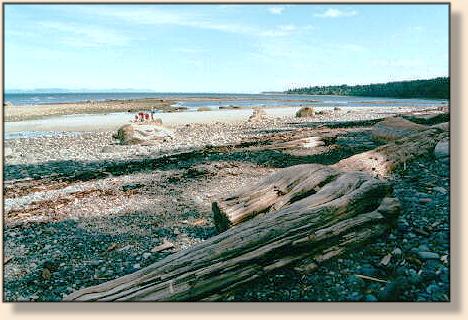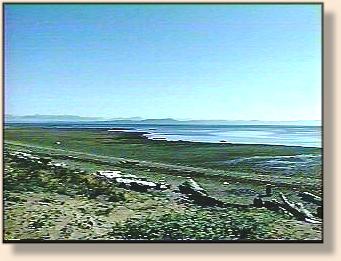Coho on the Fly, Vancouver Island, British Columbia
By Ian Roberts
Throughout my years of fly fishing, I have shared campfires and dinner tables with many
'well-seasoned' angers. These monitors of "how great the fishing used to be" frequently
made it seem like the time had come to hang up my rod and waders and leave the beaches
altogether. No longer. Last season [1999] marked the beginning of the return to the
glory years on Vancouver Island beaches and suddenly everything changed. The
much-revered coho returned in unimaginable numbers and, best of all, this was no
accidnet. While the recent commercial and sport fishing closures produced regrettable
hardship for commercial fisher, guides and lodges, the results were unequivocal: never
in recent memory have there been so many fish at the esturaries and beaches as there
were last fall.
One old-timer I met claimed to have released 170 coho since the first one of the season
leapt from the water at his favorite beach. It sounded more to me like a statement of
lifetime achievement than a one-season total, but I was about to discover otherwise.

Arriving at first light after a three-hour drive to a Courtenay/Comox-area beach, partner
David Wallden and I found the conditions less than ideal. The wind had blown up to
the point that casting would be difficult and a light rain contributed to that West Coast
feeling. Nevertheless, we geared up with expectant haste and made our way to the beach.
At first there was no visible evidence of fish. The pounding waves had stirred up the normal
assortment of 'lettuce' and jetsam, so we had to wade out thigh deep to reach clean water.
As the sky started to brighten, we spotted our first fish. They were farther along the beach,
off a small point that sloped away from the beach and estuary. Both David and I had tied on
chartreuse flies that were weighted to swim with the hook point up, and upon arrival at the
pont we began to cast them to a large school of coho that was within 20 feet of shore. David
immediately hooked a fish that accelerated along the drop-off, breaking him off on some
barnacled rocks. It would be the first of many fish that never quite made it into our hands, but
was no less exciting for the slightly truncated fight.
By mid-morning the tide had begun to flood and was moving well off the end of our point.
The rain had stopped and the sun had come out to reveal a scene so spectacular it made
us just stop and stare for a moment. As each jade-colored wave crested and rolled towards
shore, schools of coho coursed along its length like alectricity through a wire, each fish
delineated as if frozen by a camera's flash. Within casting range there were never fewer
than 30 or 40 fish. It is a sight I will never forget.
Jolted out of our reverie, we began casting our stillwater lines beyond and slightly ahead
of each group of fish, retrieving in short, rapid, six-inch strips. When the strikes came,
they were heavily weighted attacks that literally tore the line from our hands, snapping all
slack line off the water's surface in an instant. Nearly every fish showed us why coho are
spoken of in such reverent tones by fly fishers.

By the end of the next two hours, I had released eight coho, all bright, active fish that
had shown me lots of backing and stretched my line perfectly straight. All of the fish
had taken the #8 chartreuse fly.
David had enjoyed similar success, but it now became apparent the fish were no
longer interested in our offering, despite good presentations and altered retrieves.
Naturally it was at this point that a school of noticeably larger fish caught our
attention. Whey were slightly farther out than the fish we had been hooking,
but still within reach. Time was the critical factor now - could be solve the
puzzle before the fish moved off?
A brief but intense discussion on fly selection left David still using the first fly,
while I changed to a blue version of the same pattern. The results were immediate
and bone jarring. On the first cast I hooked a much larger fish than had so far
been fooled, and it took such a sharp and prolonged run that it had rapped
the reel handle on my thumb no fewer than four times before I could move
my hand away. After a protracted battled which culmimated in the famous
'coho death roll', I used the waves to surf him closer until I could tail hilm.
He was a magnigicent, solid (and honest), 12-pound buck, unblemished by nets
or seal attack and with the beautiful translucent violet stripe above his lateral
line, for which coho are so well known.
I hooked several more fish before bottoming out in a second period of inactivity.
It didn't take long to arrive at the logical conclusion: the fish had seen enough
of my blue fly. I changed once more, this time to a red version in the same
pattern. Once again, on the first cast with the new fly I hooked a fish which
fought brilliantly, causing my leader to throw off a bow wave as it zipped
through the water.
We might have called it quits at that, but the sight of occasional 20-plus-pound fish
launching from the troughs of the waves was all the inspiration we needed to stay
put, never mind the thrashing we were taking from the ocean. I could tell from the
sound of Dave's reel that he too had changed flies and was enjoying the
same action I was, but I also knew that our retreat was imminent due to the
height of the tide.
 Finally, at 2:00 in the afternoon, the tide had risen to the point that the fish were
effectively out of casting range. Our stomachs were signalling that lunch was well
overdue, so we proceeded to the nearest log to sit down. Our shoulders and
wrists were aching from the strain of the morning's fishing, but two bigger smiles
had never graced our faces. We had been fishing for eight hours and had,
between us, released 36 coho, hooking and losing perhaps that number again.
We sat in silence for awhile, each of us remembering our most exceptional fish
and realizing that, if for this one day, we had re-captured something of the historic
heyday of Vancouver Island's beach fishing.
Finally, at 2:00 in the afternoon, the tide had risen to the point that the fish were
effectively out of casting range. Our stomachs were signalling that lunch was well
overdue, so we proceeded to the nearest log to sit down. Our shoulders and
wrists were aching from the strain of the morning's fishing, but two bigger smiles
had never graced our faces. We had been fishing for eight hours and had,
between us, released 36 coho, hooking and losing perhaps that number again.
We sat in silence for awhile, each of us remembering our most exceptional fish
and realizing that, if for this one day, we had re-captured something of the historic
heyday of Vancouver Island's beach fishing.
David turned to me with a laugh and said, "You know, I don't think I care if I die now."
Amen.
~ Ian Roberts
Credits: From Fly Fishing British Columbia
edited by Karl Bruhn. We thank
Frank Amato Publications, Inc. for use permission!
Our Man In Canada Archives
|



